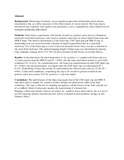| dc.contributor.author | Hiscox | |
| dc.contributor.author | Otieno, B | |
| dc.contributor.author | Kibet, A | |
| dc.contributor.author | Mweresa, C K | |
| dc.contributor.author | Omusula, P | |
| dc.contributor.author | Geier, M | |
| dc.contributor.author | Rose, A | |
| dc.contributor.author | Mukabana, W R | |
| dc.contributor.author | Takken, W | |
| dc.date.accessioned | 2014-08-07T11:20:03Z | |
| dc.date.available | 2014-08-07T11:20:03Z | |
| dc.date.issued | 2014 | |
| dc.identifier.citation | Hiscox, A., Otieno, B., Kibet, A., Mweresa, C. K., Omusula, P., Geier, M.,Rose,A.,Mukabana,W.R.,Takken, W. (2014). Development and optimization of the Suna trap as a tool for mosquito monitoring and control. Malaria journal, 13(1), 257. | en_US |
| dc.identifier.uri | http://hdl.handle.net/11295/73709 | |
| dc.description.abstract | Background: Monitoring of malaria vector populations provides information about disease transmission risk, as well
as measures of the effectiveness of vector control. The Suna trap is introduced and evaluated with regard to its
potential as a new, standardized, odour-baited tool for mosquito monitoring and control.
Methods: Dual-choice experiments with female Anopheles gambiae sensu lato in a laboratory room and semi-field
enclosure, were used to compare catch rates of odour-baited Suna traps and MM-X traps. The relative performance
of the Suna trap, CDC light trap and MM-X trap as monitoring tools was assessed inside a human-occupied experimental
hut in a semi-field enclosure. Use of the Suna trap as a tool to prevent mosquito house entry was also evaluated in the
semi-field enclosure. The optimal hanging height of Suna traps was determined by placing traps at heights ranging
from 15 to 105 cm above ground outside houses in western Kenya.
Results: In the laboratory the mean proportion of An. gambiae s.l. caught in the Suna trap was 3.2 times greater than
the MM-X trap (P < 0.001), but the traps performed equally in semi-field conditions (P = 0.615). As a monitoring tool ,
the Suna trap outperformed an unlit CDC light trap (P < 0.001), but trap performance was equal when the CDC light
trap was illuminated (P = 0.127). Suspending a Suna trap outside an experimental hut reduced entry rates by 32.8%
(P < 0.001). Under field conditions, suspending the trap at 30 cm above ground resulted in the greatest catch sizes
(mean 25.8 An. gambiae s.l. per trap night).
Conclusions: The performance of the Suna trap equals that of the CDC light trap and MM-X trap when used to sample
An. gambiae inside a human-occupied house under semi-field conditions. The trap is effective in sampling mosquitoes
outside houses in the field, and the use of a synthetic blend of attractants negates the requirement of a human bait.
Hanging a Suna trap outside a house can reduce An. gambiae house entry and its use as a novel tool for reducing
malaria transmission risk will be evaluated in peri-domestic settings in sub-Saharan Africa. | en_US |
| dc.language.iso | en | en_US |
| dc.publisher | University of Nairobi | en_US |
| dc.subject | Anopheles mosquito, Malaria vector, Suna trap, CDC light trap, MM-X trap, Attractant, Odour bait, Surveillance | en_US |
| dc.title | Development and optimization of the Suna trap as a tool for mosquito monitoring and control | en_US |
| dc.type | Article | en_US |
| dc.type.material | en | en_US |

